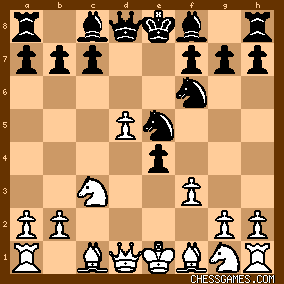Chessical: The players comments as reported in the press:
The first game of the match between Gunsberg and Steinitz was conducted by the two players with a considerable show of caution, and Steinitz admits that an attacking player would have acted differently from what he did , whilst Gunsberg remarked that he was convinced that Steinitz would not
have consented to a draw had he possessed the black men at the finish. Before proceeding boldly,however, Gunsberg desired to know more about the play of his antagonist. General hopes are expressed that the competitors will show more dash in the conduct of their future games. <Move 4 white> - The two players agree in describing White's forth move <f3> as entirely new at that stage. Mr Steinitz adopted it with a view to forming a centre, and the taking advantage of the confined position of the adverse QB. Gunsberg remarks it will be seen the move enable White to utilise his N to fortify his centre, by bringing it to <f2> via <h3>. Steinitz considers the reply <4...Nc6> as probably the best way to stop the advance in the centre, although, as Gunsberg points out , his advice in close openings is not to develop this <Nc6> opening before the
<c> pawn has been moved.
Black's reason for playing the move was to force White to advance <e3>, a course necessary to prevent the loss of a pawn by <dxc4>. <Move 5 White> - Steinitz points out that <5.e4> would have led to a good game for Black by <5...dxe4> 6.d5 exd5 7. cxd5 Ne5 
click for larger viewand regards his own move of <6.Nh3> as providing a better outlet for the N later on than if it stood at <e2>, for this latter plan would have necessitated him playing <Bd3> , whereupon the piece could have been attacked by <Nb4> <Move 9 Black> - Gunsberg considers that by the properly prepared move of <9...e5> Black assumes the initiative , preventing his opponent from establishing a strong centre, and finally breaking up his Queen's wing. <Move 11 White> - Instead of the move actually made, Steinitz says he would have done better by 
click for larger view<11. Nd3> Bxc3 12. bxc3 Re8 13. cxd5 Nxd5 (or Qxd5) 14. e4. Gunsberg points out that <12. Nd3> would have been met by <12...Bxc3>, and he remarks that he possessed the better position for the end game after making his thirteenth move, whilst the retirement of the R to <e8> placed it in a safer position, and rendered it more useful than if stationed elsewhere. <Move 17 Black> - Both players comment on the tempting appearance of <17..f5> for Black, which they agree would be met by <18. Nf4> when if <18...fxe4>
White retakes, and obtains a very open game and a powerful attack. | 




